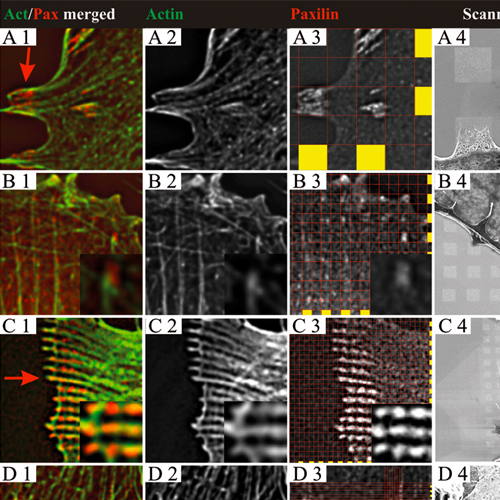Cell interactions with hierarchically structured nano-patterned adhesive surfaces
10-Nov-2008
The activation of well-defined numbers of integrin molecules in predefined areas by adhesion of tissue cells to biofunctionalized micro-nanopatterned surfaces was used to determine the minimum number of activated integrins necessary to stimulate focal adhesion formation. This was realized by combining micellar and conventional e-beam lithography, which enabled deposition of 6 nm large gold nanoparticles on predefined geometries. Patterns with a lateral spacing of 58 nm and a number of gold nanoparticles, ranging from 6 to 3000 per adhesive patch, were used. For v3-integrin activation, gold nanoparticles were coated with c(-RGDfK-)-thiol peptides, and the remaining glass surface was passivated to prevent non-specific protein adsorption and cell adhesion. Results show that focal adhesion formation is dictated by the underlying hierarchical nanopattern. Adhesive patches with side lengths of 3000 nm and separated by 3000 nm, or with side lengths of 1000 nm and separated by 1000 nm, containing approximately 3007 ± 193 or 335 ± 65 adhesive gold nanoparticles, respectively, induced the formation of actin-associated, paxillin-rich focal adhesions, comparable in size and shape to classical focal adhesions. In contrast, adhesive patches with side lengths of 500, 250 or 100 nm, and separated from adjacent adhesive patches by their respective side lengths, containing 83 ± 11, 30 ± 4, or 6 ± 1 adhesive gold nanoparticles, respectively, showed a significant increase in paxillin domain length, caused by bridging the pattern gap through an actin bundle in order to mechanically, synergistically strengthen each single adhesion site. Neither paxillin accumulation nor adhesion formation was induced if less than 6 c(-RGDfK-)-thiol functionalised gold nanoparticles per adhesion site were presented to cells.











